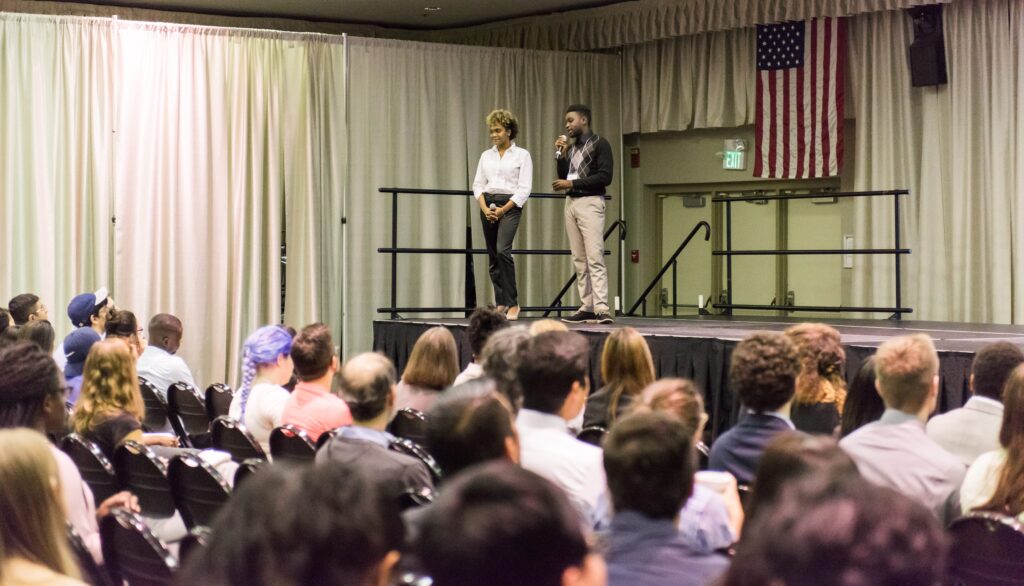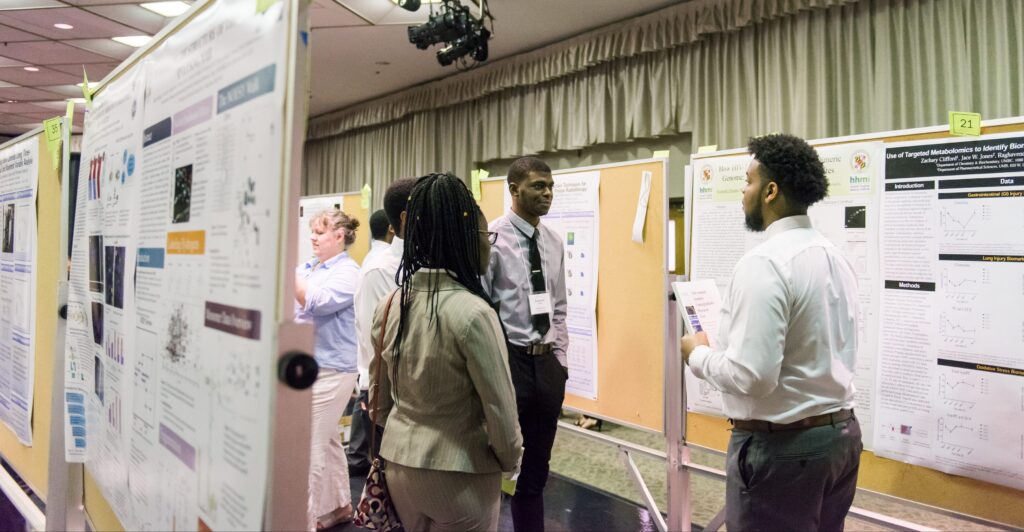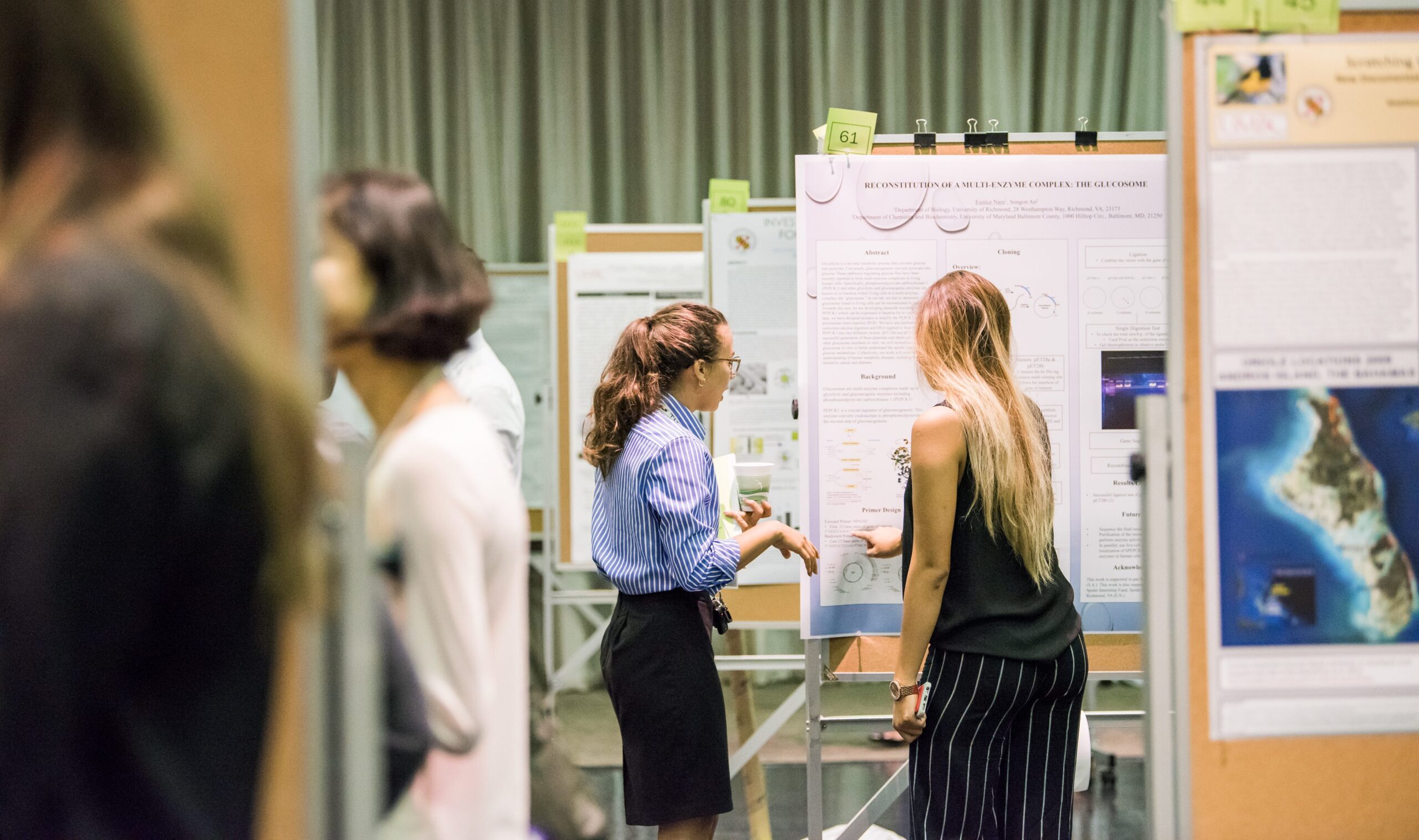Marking the last weeks of the season, UMBC’s University Center Ballroom buzzed with a contagious energy last month as more than 150 undergraduate and high school students from across the U.S. shared the results of summer research they had conducted with UMBC faculty and graduate student mentors.
“It is a privilege to have so many students coming from far and near to participate in the authentic research experience UMBC provides,” shared Dean Bill LaCourse, of the College of Natural and Mathematical Sciences. As he told the crowd gathered for UMBC’s 20th Summer Undergraduate Research Fest (SURF), “It’s not cookbook—it’s real science we’re doing here.”
LaCourse acknowledged that spending a summer away from home can be challenging, but by immersing themselves in their summer research, students also gain “another community: a scholarly community.”

To kick off the day’s program, five groups of students presented their research, beginning with Kaaliyah McDowell, of Morgan State University, and Carl Bannerman, Community College of Baltimore County, who explained their study exploring phages (viruses that infect bacterial cells) in nearby freshwater sources. The team also included Jonathan Poole, of Gallaudet University, and Jackson Narrett ‘17, biological sciences. Together, they worked with Tagide deCarvalho, manager of UMBC’s Keith Porter Imaging Facility, through the STEM BUIILD program.
Angelie Matar, a rising junior at Louisiana State University, shared her progress in improving a chemotherapy drug delivery mechanism. Working with Marie-Christine Daniel-Onuta, associate professor of chemistry and biochemistry, Matar succeeded in attaching a drug molecule and a fluorescent dye to gold nanoparticles, which creates “a more efficient, multi-functional nanoparticle for chemotherapy,” that also reduces chemotherapy’s toxicity to healthy cells, Matar explained.
Caroline Larkin ’17, bioinformatics, is researching cancer from a very different angle. Working with Daniel Lobo, assistant professor of biological sciences, she’s using artificial intelligence to create a computer program that will decode how different cell types within a tumor interact to influence its growth, metastasis, or collapse. The eventual goal is personalized medicine, by using a similar program to predict what course of treatment would be most effective at destroying a particular tumor in a particular patient.
Adam Ring, a rising senior at Emory University, participated in this summer’s SCIART fellowship, a collaboration between UMBC, Johns Hopkins, and the Walters Art Museum in Baltimore. Ring and fellow SCIART participants Chloe Cao, rising senior at Johns Hopkins University, and Hope La Farge, recent alumna of the University of British Columbia, worked with Daniel Rowlands, visiting lecturer in chemistry and biochemistry at UMBC, and Terry Drayman-Weisser, retired director of conservation and technical research at the Walters, to develop techniques for determining the origins of illegal ivory. By detecting trace metals in ivory samples, the team could locate the ivory’s origin based on which water sources the elephants consumed. The findings are critical to helping governments crack down on illegal poaching and ivory trade.

Students also expressed how much the summer experience meant to them as they prepare to make choices about their futures. Mark Minnis ’18, information systems, spent his summer working in the UMBC lab of Amy Hurst, associate professor of human-centered computing, as well as a makerspace she developed in Baltimore for local high school students. There, Minnis helped to devise and implement a more effective workflow system for student staff members, which gave him a broader sense of the possibilities for a research career. He shared, “I had an amazing experience.”
Chelsea Mikal worked with Lee Blaney, associate professor of chemical and environmental engineering, to measure the absorbance characteristics of sunscreens. Sunscreens can end up in waterways, and the light they absorb can affect photosynthetic life. Mikal is a rising junior at Mt. Hebron High School in Howard County. Though not yet an undergraduate, she already knows where her research interests lie. The experience has “definitely pushed me in the research direction,” she shares, “and Dr. Blaney is an amazing mentor.”
Dean LaCourse encouraged these presenters, and the dozens of others who participated in SURF, to be proud of their work, not just for how it helped them grow as researchers, but also as tangible contributions to their scientific fields. “I assure you that your discoveries have added to scientific knowledge, which in the end benefits society through empowerment,” he shared.
As the students prepared to return to their homes and universities across the nation, LaCourse reflected that the UMBC student research experience would always be a part of them. “Hopefully,” he said, “this summer we’ve lit a flame of passion that will drive you to greater undertakings.”
Banner image: Students discuss their summer research during a SURF poster session. All photos by Marlayna Demond ’11 for UMBC.
Tags: Biology, CBEE, ChemBiochem, CNMS, COEIT, IS, STEMBUILD, Undergraduate Research

